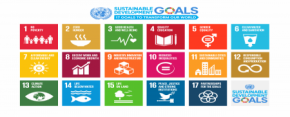End Poverty, Protect the Planet, and Ensure Prosperity for All - Part 2
End Poverty, Protect the Planet, and Ensure Prosperity for All - Part 2
 The next one is tough. On sustainable economic growth, while we do have businesses and economists talking about climate impacts and risks to markets and supply chains, and plenty of talking points when it comes to green jobs and green growth, we’re short on re-evaluating and ultimately replacing the models and measurements inherent to the economic system. Hurricane Sandy, for example, was good for America’s economy. Extreme weather, and the damage it wreaks, is ultimately, and perversely, good for the GDP because it increases the transaction of goods and services. This is a problem, a result of faulty frameworks for measuring progress, and one of the many reasons why the GDP must be completely revamped. Additionally, if we’re serious about just jobs and a just transition, we’re going to have to value people as much as we value the planet. Treating either as discardable or dispensable, which our economic system has done for too long, and we’ll fall short on both SDG and climate deals.
The next one is tough. On sustainable economic growth, while we do have businesses and economists talking about climate impacts and risks to markets and supply chains, and plenty of talking points when it comes to green jobs and green growth, we’re short on re-evaluating and ultimately replacing the models and measurements inherent to the economic system. Hurricane Sandy, for example, was good for America’s economy. Extreme weather, and the damage it wreaks, is ultimately, and perversely, good for the GDP because it increases the transaction of goods and services. This is a problem, a result of faulty frameworks for measuring progress, and one of the many reasons why the GDP must be completely revamped. Additionally, if we’re serious about just jobs and a just transition, we’re going to have to value people as much as we value the planet. Treating either as discardable or dispensable, which our economic system has done for too long, and we’ll fall short on both SDG and climate deals.
We’re getting there slowly, but surely, on industry, infrastructure and innovation. Narratively speaking, this fits nicely with most countries’ cultural frameworks. No one wants to miss the cutting edge of whatever is being innovated, and no one wants to miss out on the market share. Smarts grids, and the efficiencies they guarantee, make common sense. Resilient infrastructure that can withstand the next storm makes sense. Products that are less reliant on petro-chemicals, since we need to keep fossil fuels in the ground, make sense. All of this is common sense. Even energy efficiency makes bipartisan sense in a very politically divided US Congress. To ignore the opportunities relegates one to a Luddite legacy and comes with a clear economic cost. Innovators who understand the transformative market signal that emanated from Paris are already outperforming the industries that remain intransigent.
We all know the gap between the rich and the poor, within and among nations, is growing and reaching record levels. Policymakers who are fluent when it comes to income inequality stats and data trends, however, have yet to layer on carbon use and climate change. That growth gap invariably came at someone’s expense. In almost every case, for every rich person and rich country, you can find the poor person or poor country, exhausted and extracted and poorly remunerated, which made those riches possible. America’s rich world fascination with the latest smart phone, for example, is only made possible through poor working and environmental conditions in China and elsewhere. Similarly, fossil fuel facilities are consistently located within poor, minority communities, and, remarkably, coal is still advocated as a fix for poor populations in developing countries. Making climate solutions clean, renewable, accessible and affordable will help bridge this gap. It obviously won’t fix the financial system, which skews the gap further, but it’s a start.
Now on to cities, which is where some of the most exciting sustainability and climate actions are occurring – due, in part, to cities’ ability to move policy more quickly and engage citizens more readily than state or federal counterparts. It’s also happening in cities because it has to: Cities are the biggest contributors of global greenhouse gas emissions (over 70 percent); cities are where the majority of the world’s population will reside in the coming decades (70 percent by 2050); and cities are on the front lines of climate impacts. Most major cities now have resiliency offices. Most major cities also have sustainability directors. And there are organizations set up to support them, such as the Urban Sustainability Directors Network and the Carbon Neutral Cities Alliance. The key now, post-Paris (where many cities signed up to various pledges, targets and timelines), is for mayors and city councils to get voters involved in the move towards more mass transit, less pollution and waste, better pedestrian and bike policies, and more. That way it sticks the next time another mayor moves in and wants to rethink past precedent.
Here’s the real rub for both sustainability and climate communities: consumption and production. We need a very different kind of American dream (or insert any other country and their corresponding aspiration). Per capita emissions are way too high (which is why the Under 2 MOU work is so important, getting us to 2 tons of carbon emitted annually per person), especially in the rich world, and they’re only going to get higher as commercial pressures to consume and discard increase. Fast fashion – one of the heaviest users of oil-based products, energy and toxins – is a fine example, as most clothes are worn but a few times before being discarded. Technology is another as many users unnecessarily upgrade, and consequently discard, every imaginable device on a near annual basis. Food is yet another as the world wastes one-third (40 percent in the US) of what we produce. This has got to stop, especially as the global population adds another 2 billion tech users, food eaters and clothing-wearers in the next few decades. And we haven’t even discussed cars, houses and all the other pressures to consume. There simply aren’t enough resources for this kind of profligate consumption and wasted production. We’re all going to have to be a lot leaner going forward, and the rich world – and its extraordinary media and advertising machine – will have to lead the way.
On climate, we’ve now got a plan out of Paris. There’s global consensus that we have to limit warming to 2 degrees Celsius (above pre-industrial temperatures) and aim for even lower, at 1.5. We’ve already warmed 1 degree, leaving little wiggle room and forcing remaining fossil fuels to stay below ground. A carbon-free economy is now a goal for the latter half of this century. All of this is good, but it must stick and get stickier, moving from aspiration to reality. Nations will meet regularly to ratchet up the voluntary climate-related commitments they’ve offered over the last year in the run-up to Paris. That’s also good. Hopefully peer pressure will result in more aggressive goal setting. There’s finally some money on the table for poorer nations to adapt to climate change and recover from the loss and damage from extreme weather and global warming-related effects. In short, the world is on board. That’s huge. Going forward, anyone who is pro-fossil fuels will be sitting on the margins of history, an outlier in what is an overwhelming overture to save the world from warming.
The immediate Paris-related business now, however, will be in saving the oceans and the forests before they’re completely wrecked. We’ve over-harvested and over-exploited both, over-fishing the oceans and over-clear-cutting the forests. Ocean’s capacity to store carbon and heat from the atmosphere has acidified and warmed the seas, making much of marine life unsustainable. Forests’ and soil’s capacity to store carbon has meant that global deforestation, as a result of animal but also palm oil production, and, more recently, drought-induced wildfires have released billions of tons of carbon into the air. Keep in mind new trees won’t be able to capture that CO2 quickly. Old-growth forests, peat bogs and tropical rainforests, which take decades to grow, are especially efficient and effective at storing large amounts of carbon. This brings us back to the interconnected nature of these SDGs and climate action. Saving the seas and the trees will require more sustainable agriculture, more sustainable consumption and more sustainable water use. It’s all related, as our oceans and forests know well.
Failure to fix any or all of the above puts the world in a seriously unstable and insecure situation. Peace and justice, and the institutions that enable them to prosper, will be all but non-existent if we don’t preempt resource, water and food scarcity. As the US and UK defense departments have already intoned countless times, climate change is a threat multiplier and will prey on unstable environments, exacerbating poverty, terrorism and migration trends. Water wars, food wars, and resource wars are all part of a future full of climate conflict if we don’t get this right. This is why climate change must be a part of the UN Security Council’s mandate, which it currently is not. The council’s parameters are old ones and must be updated to reflect current risks and threats.
Lastly, this needs to be done with all hands on deck. All partnerships possible must be pursued. No one is exempt. No business, no policymaker, no academic, no civil society group, no lawyer, no marketing professional, no educator, no builder, no designer, no engineer, no doctor, no landscaper…no one. And it’s going to require some unusual allies and unprecedented partnerships – including pairing up committees and councils within the UN to ensure preventive and preemptive approaches.
That means that the Security Council is coordinating directly with the Economic and Social Council, as the issues are increasingly inseparable. That means that the UN’s climate team, what’s left of it post-Paris since it’s being downsized, is consulting on every part of the SDG agenda. That means that governments, such as the US, are integrating climate and sustainability thinking into every department, whether housing, health, or homeland security. Since climate and sustainability impact almost every aspect of social, economic and environmental decision-making, it’s got to have a seat at the table.
Managing those partnerships alone, at the institutional level, would significantly improve our chances of meeting any of the goals above. Short of achieving that, however, we can immediately start, as individuals, considering climate and sustainability in every decision we make: what we consume in food and fashion, how we transport and house ourselves, the technology we use, and every other lifestyle decision we make. None of this is possible without the public’s active participation – neither the SDGS nor the climate commitments. Elected leaders are only half of the equation. We are the rest. The time to start cracking on this is now. We’ve got 15 years to solve this thing.
### Part 1 of this article is available at: http://scar.gmu.edu/newsletter-article/end-poverty-protect-planet-and-ensure-prosperity-all-part-1




